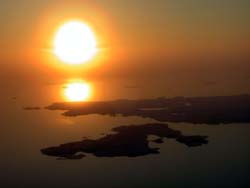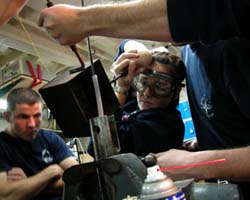|
|
 |
 |
 |
|
The sun’s reflection on the still water at about midnight created the illusion of a “double sun.” |
|
Click to enlarge |
Daily Update
Calendar
Dispatch 19 - August 2, 2002
By C.A. Linder
Weather conditions: clear skies, wind 12 knots from the SW, calm seas, air temperature 44° F.
Fata Morgana
Last night around 2AM, the sun dipped into a low fog bank and tinted the icy seascape with peach and magenta hues. At that moment I arrived at a word to describe this place -- surreal. I looked out from my perch in the bow of the ship and almost laughed at the beauty that stretched in every direction. The Polar Star was caught in huge blocks of ice where only moments before we had been cruising through open water. The ice was tumbled together like an upended box of giant-sized Legos. The ship rumbled to a slow halt and slid back down off the ice floes. After a few minutes, the engines sprang back to life and the ship turned to follow an opening in the ice. I watched the glowing orb of the sun flatten as it neared the horizon. Then it sank behind the wall of fog.
The main lab was quiet this morning. There were no CTDs last night and none are expected in the next couple of days. It was an excellent time for catch-up work. Jim Schmitt was working in his lab, analyzing our CTD bottle samples for their salinity (salt) content. Aaron Morello was also working with bottle samples, measuring the nutrients of the cold Arctic waters. The WHOI mooring crew packed up their extra gear and filled out paperwork.
 |
 |
|
Rebecca Albert pours the liquified metal alloy to secure the new CTD termination.
|
|
Click to enlarge |
Sarah Zimmermann was busy looking at the temperature and salinity data from the CTD when she noticed a small problem - “spikes” or obviously wrong data points - interspersed with the good data. Often when this happens the culprit is the weakest link in the system - the point where the data cable meets the CTD package, also known as the “termination.” When salt water gets into this sensitive connection, the data stream can be interrupted or even fail completely. It seemed like a good time to “reterminate” (essentially to take apart and put together again) this cable connection -- a complicated process that can take half a day.
While the science team members were working inside the ship, the Arctic was putting on a spectacular light show. In the morning, while we steamed through a thin fog bank, a beautiful fogbow, a colorless arc similar to a rainbow, formed over the ship’s bow. It persisted for a few hours, until the fog burned off. After dinner, I was pulled away from my dispatch writing and told to bring my camera outside. At first, nothing seemed odd - the sun was shining brightly, and the air was warm, but this wasn’t unusual. Then I took a closer look at the horizon. Rising up out of the ice far in the distance were vertical walls and columns with turrets! It looked like the huge Antarctic ice sheets had somehow traveled to the Arctic and were sitting just on the horizon. After a few photos I ran back inside to check my trusty Meteorology Today textbook, which has been next to my computer since we entered the ice. Sure enough, this effect was described in the book - the Fata Morgana, a mirage formed when a layer of warm air overlies a cold surface (such as the Arctic Ocean). The light is bent in such a way that the ice appears to rise vertically out of the horizon. Even more interesting is the origin of the term Fata Morgana... It’s Italian for “fairy Morgan,” the half-sister of King Arthur. Legend has it that Morgan lived in a crystal palace underwater, and could use magical powers to build castles out of thin air. As I stood there marveling at the distant walls, the word came to my head again -- surreal.
As we rounded the northern tip of Alaska today, one of the helicopters brought Marine Science Technician Chief Sean McPhilamy to the nearby town of Barrow. He had been suffering from back pain, and we hope he is feeling better soon. His cheerful attitude and experience will be sorely missed. We also bid farewell to another member of our science party - Sarah Thornton, who deployed her nitrate analyzer earlier in the cruise. Although it can’t be proven, she seems to have timed her departure to evade participating in the “Bluenose” Arctic circle crossing ceremony which is scheduled for tomorrow...
To view more photos from this dispatch and others, visit the image gallery. Also, be sure to check the gallery after I get back to WHOI in September - I will be scanning and posting the wildlife and seascape photos I have been shooting on slide film.
 Previous Dispatch
Next Dispatch Previous Dispatch
Next Dispatch

Back to Calendar
|
|




